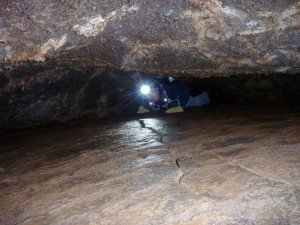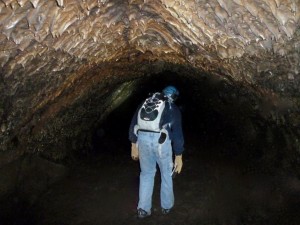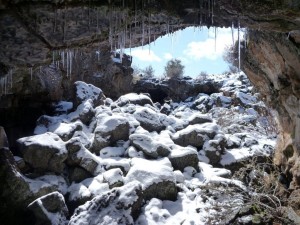Vagabonding Field Report: Road tripping in Northern California – exploring the underworld at Lava Beds National Monument
Cost: $50/day
What’s the strangest thing you have seen lately?
Lavacicles. These pointy tooth-like projections can be found on the roofs of many of the incredible lava tubes and caves at Lava Beds National Monument in northern California. They formed when viscous lava that was dripping from the top of the tubes cooled and hardened. The tubes themselves were forged when the outer edges of flowing lava from the Medicine Lake Volcano cooled and hardened leaving the inner lava insulated and free flowing. Eventually the lava stopped moving and some of the tubes collapsed in on themselves creating hundreds of caves. This type of cave formation is relatively unique as the vast majority of caves are formed when soluble rock, usually limestone, is eaten away by water over thousands of years.
Like many caves, there are strange creatures that dwell within, including unusual silver insects, bats and subterranean flesh eating humanoids. Actually the flesh eating humanoids are from the 2005 movie ‘The Descent‘, however when you turn your head lamp off and the darkness engulfs you it’s difficult not to think of ghastly horrors. The darkness in a cave is complete and it is bizarre to think how unaccustomed we humans have become to living without light. Once you laugh off the thought of your flesh being gnawed from your bone there is real peace to be found in the darkness.
In addition to lavacicles some of the cave walls glow silver and golden as the light from your head lamp reflects off of water beading from clumps of yellowish bacteria. I’m sure some poor chap thought he had struck gold when he first viewed this phenomenon. The whole experience has got me excited about future spelunking opportunities. Apart from being fascinating it’s nice to see the confused and mildly disgusted look someone gives you when you said you went ‘spelunking’ recently.
Describe a typical day:
Wake in a cheap roadside motel, tent or someone’s couch. Head into the inky blackness of some caves to crawl around, bump my helmet head on lavacicles, and marvel at the strangeness of it all. Emerge into a winter wonderland.
On this most recent road trip most of ?my time was spent spelunking, however above ground there was ample opportunity for wildlife viewing, some spectacular hikes, snowboarding and time to delve into the rich human history of the area. Northern California is a sensational area to explore and one finds it difficult to get bored.

Describe an interesting conversation you had with a local:
Before heading into the caves we met Jesse, a young man who road tripped his way from Tennessee to start a national park internship at lava beds. Despite being paid a meagre $70 a week he is happy to spend the next four months in this beautiful part of the world and hopes to become a US national park ranger. We ended up splelunking all day with him (erm……that sounds weird) and he was kind enough to offer up his couches to crash on so we didn’t have to camp in the cold (Bear Grylls would be ashamed of us). He enlightened me on the existence of the sport of ultimate frisbee, which apparently he took quite seriously in college and is a legitimate sport these days. Although I get the feeling placing the word ‘ultimate’ before any activity makes it sound a lot cooler than it actually is I was intrigued to hear of the level of skill and fitness that the players are required to have. Once I figure out how to throw a frisbee I might seek out a way to partake in a game one day. Until then its ultimate hiking and ultimate spelunking for me.
What do you like about where you are? Dislike?
The remarkable volcanic landscape with views of the incomparable Mount Shasta are hard to beat. It’s difficult to find anything to dislike about travelling through this part of the world. Although California is not the cheapest travel destination it is easy to find cheap roadside motels and plenty of great camping spots. I was lucky enough to be traveling with a companion so even with the high price of gas it was a cheap trip. Traveling alone on the other hand could get quite expensive, especially if you have to rent a car and gear. It’s obviously quite cold in northern California at certain times of the year, particularly if you are camping, and I had to suppress the urge to whine about my cold fingers from time to time. This, however, is a small price to pay to be surrounded by such beauty.
Describe a challenge you faced:
Apart form the physical challenge of squeezing myself between jagged rocks (Jesse the intern described this as ‘like being birthed’) it was surprisingly hard at times to figure out our next move due to the lack of internet access and spotty phone reception. I’m almost ashamed at how reliant I have become on the internet when planning my travels. Being without the internet does have its advantages- you are required to chat with locals or fellow travellers and often you stumble upon adventures that you never would have found otherwise.
What new lesson did you learn?
This road trip was more or less a practice run building up to a longer one next month and several months of travel throughout central and South America. I packed my bag as if I was going travelling for several months and discovered that although bundle wrapping clothes sounds like a great idea I will inevitably end up just shoving my clothes in my bag in a random hap hazard way, hoping that they all fit. Therefore I will eliminate some items of clothing in favor of more room so I can just hastily cram all my clothes in my pack. I highly recommend a practice trip, even if its only for a couple of days to work out what you really want to bring before going on a longer trip.
Where next?
To my homeland Australia for three weeks and then back to the USA for another road trip- the Grand Canyon and Utah national parks.



Category: Adventure Travel, North America, Vagabonding Field Reports